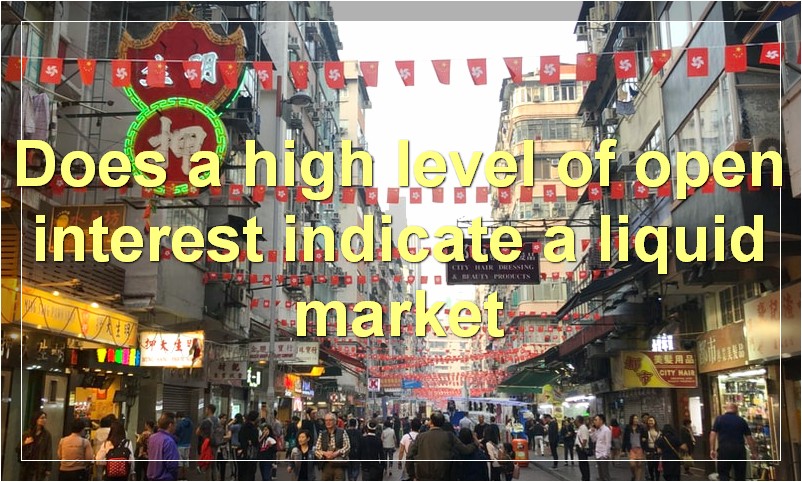If you’re an investor, it’s important to know about open interest. Here’s everything you need to know about this important metric.
What is open interest
Open interest is the number of outstanding contracts that are held by traders at the end of the day. It is a key metric for determining the health of a market, as it shows the number of active participants. Open interest can be used to gauge market sentiment, as an increase in open interest typically indicates more buying pressure while a decrease indicates more selling pressure.
How is open interest calculated

Open interest is calculated by taking the total number of open contracts for a particular commodity and subtracting the total number of contracts that have been closed out or delivered during the same time period. This figure represents the total number of contracts that are still open and active.
What are the benefits of monitoring open interest
There are several benefits to monitoring open interest when trading futures contracts. For one, it can give traders an idea of how liquid a market is. If there is high open interest, it means there are a lot of participants in the market and it is therefore more liquid. This can be helpful information when making decisions about entering or exiting trades.
Another benefit of monitoring open interest is that it can provide clues about the future direction of prices. If open interest starts to increase rapidly in one direction, it could be an indication that prices are about to move in that same direction. Conversely, if open interest starts to decrease rapidly, it could be an indication that prices are about to reverse course.
Finally, monitoring open interest can help traders gauge the level of bullish or bearish sentiment in the market. If open interest is rising and prices are simultaneously moving higher, this is generally seen as a bullish sign. On the other hand, if open interest is falling while prices are declining, this is generally viewed as a bearish sign.
How can open interest be used to gauge market sentiment
Open interest is the number of outstanding contracts on a given security. It is used to gauge market sentiment because a rise in open interest indicates that more people are buying the security, while a decline in open interest means that fewer people are buying the security.
What is the difference between open interest and volume
Open interest is the number of outstanding contracts that have not yet been settled. Volume is the number of contracts traded during a particular time period.
Does a high level of open interest indicate a liquid market

A liquid market is one in which security prices are relatively stable and buying and selling can be done with little effect on the price. A market with a high level of open interest, meaning there are a lot of contracts outstanding, is more likely to be liquid than one with a low level of open interest. That’s because there are more market participants and more trading activity, so it’s easier to buy or sell without moving the price too much.
What happens to open interest when a contract expires
When a contract expires, open interest typically decreases. This is because traders who were holding positions in the expiring contract must close out their positions before expiration. Some of these traders may choose to roll over their positions into the next contract month, while others may exit their positions entirely. As a result, the amount of open interest in the expiring contract will decrease as expiration approaches.
Is open interest a good predictor of future price movements
Open interest is the number of contracts outstanding in a given market. It is used as a way to gauge market activity, and it can be used as a predictor of future price movements.
There are a few things to keep in mind when using open interest as a predictor. First, open interest can be affected by things like changes in the underlying asset, delivery dates, and expiration dates. Second, open interest can be affected by both buying and selling activity. For example, if there is more buying than selling, open interest will increase. Conversely, if there is more selling than buying, open interest will decrease.
Open interest can be a helpful tool when trying to predict future price movements. However, it is important to keep in mind that it is just one tool in the market analyst’s toolbox. Other factors, such as price history and technical analysis, should also be considered.
How do institutions use open interest data
Open interest data is often used by institutions to get a better understanding of the market. By looking at the open interest, institutions can see how many contracts are outstanding and where the majority of them are held. This information can help institutions make better informed decisions about their trading strategies.
Are there any drawbacks to using open interest as a trading indicator
Open interest is the number of outstanding contracts that are held by traders. It is used as a measure of market activity and liquidity, as well as an indicator of future price direction. However, there are some drawbacks to using open interest as a trading indicator.
First, open interest can be misleading in terms of market activity. For example, if there is a high level of open interest but few trades are actually taking place, it could be a sign that traders are hesitant to enter into new positions. Second, open interest can be influenced by factors other than actual trading activity, such as the expiration of contracts or changes in margin requirements. Finally, open interest can lags behind price movements, so it may not be the best indicator for short-term trading decisions.

